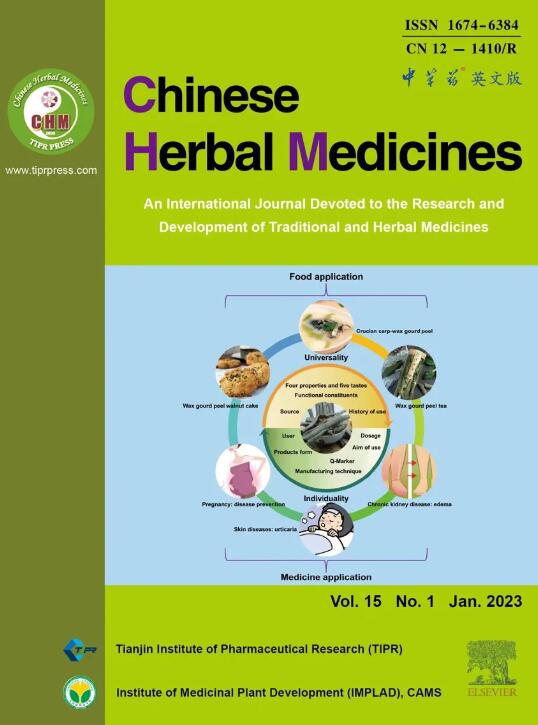以内源-外源代谢为基础,比较野生模拟黄芪和移植黄芪对慢性萎缩性胃炎大鼠的治疗作用
IF 4.7
4区 医学
Q1 CHEMISTRY, MEDICINAL
引用次数: 0
摘要
目的黄芪在中国作为治疗慢性萎缩性胃炎(CAG)的常用原料药。野生模拟AR (WAR)和市售移植AR (TAR)的疗效尚不清楚。本研究旨在进一步阐明WAR和TAR对CAG大鼠内源性-外源性代谢的治疗作用。方法采用超高效液相色谱联用四极杆飞行时间质谱(UHPLC-Q-TOF/MS)代谢组学方法,分析两种ARs治疗CAG时盲肠内容物代谢特征及代谢过程差异。结果表观药效学指标检查显示WAR组疗效更明显。代谢组学研究显示,7种内源性代谢物在两种ar中存在显著差异。此外,在治疗后,WAR组和TAR组分别鉴定出77和65种外源性代谢物。最后,选择CAG形成过程中最关键的核黄素代谢途径与相关外源组分进行分子对接,WAR得分高于TAR。结论本研究结合代谢组学和药物化学技术,分析了不同栽培形式AR的疗效差异,为中药疗效评价和质量控制研究提供了新的视角。本文章由计算机程序翻译,如有差异,请以英文原文为准。
Riboflavin metabolism involved into comparison of therapeutic action of wild-simulated and transplanted Astragali Radix to treat chronic atrophic gastritis rats based on endogenous-xenobiotics metabolism
Objective
Astragali Radix (AR, Huangqi in Chinese) has been utilized generally as a bulk drug for the treatment of chronic atrophic gastritis (CAG) in China. The efficacy of wild-simulated AR (WAR) and transplanted AR (TAR) commercially available is unclear. This study aimed to further clarify the therapeutic action of WAR and TAR to treat CAG rats based on endogenous-xenobiotics metabolism.
Methods
Ultra-high performance liquid chromatography coupled with quadrupole-time of flight mass spectrometer (UHPLC-Q-TOF/MS) based metabolomics had been used to analyze the cecal contents metabolic features and metabolic process differences of two ARs in the treatment of CAG.
Results
Apparent pharmacodynamic indicator examination revealed that the WAR group had a more substantial curative effect. Metabolomics studies revealed that seven endogenous metabolites were significant differences in two ARs. Furthermore, following treatment, 77 and 65 xenobiotics metabolites were identified in the WAR and TAR groups, respectively. Finally, the most critical riboflavin metabolic route in the formation of CAG was chosen for molecular docking with the relevant exogenous components, and WAR scored higher than TAR.
Conclusion
In this work, we analyzed the efficacy differences of AR from diverse cultivation forms by combining metabolomics and medicinal chemistry technologies, and it gave a fresh perspective for TCM efficacy evaluation and quality control research.
求助全文
通过发布文献求助,成功后即可免费获取论文全文。
去求助
来源期刊

Chinese Herbal Medicines
CHEMISTRY, MEDICINAL-
CiteScore
4.40
自引率
5.30%
发文量
629
审稿时长
10 weeks
期刊介绍:
Chinese Herbal Medicines is intended to disseminate the latest developments and research progress in traditional and herbal medical sciences to researchers, practitioners, academics and administrators worldwide in the field of traditional and herbal medicines. The journal's international coverage ensures that research and progress from all regions of the world are widely included.
CHM is a core journal of Chinese science and technology. The journal entered into the ESCI database in 2017, and then was included in PMC, Scopus and other important international search systems. In 2019, CHM was successfully selected for the “China Science and Technology Journal Excellence Action Plan” project, which has markedly improved its international influence and industry popularity. CHM obtained the first impact factor of 3.8 in Journal Citation Reports (JCR) in 2023.
 求助内容:
求助内容: 应助结果提醒方式:
应助结果提醒方式:


